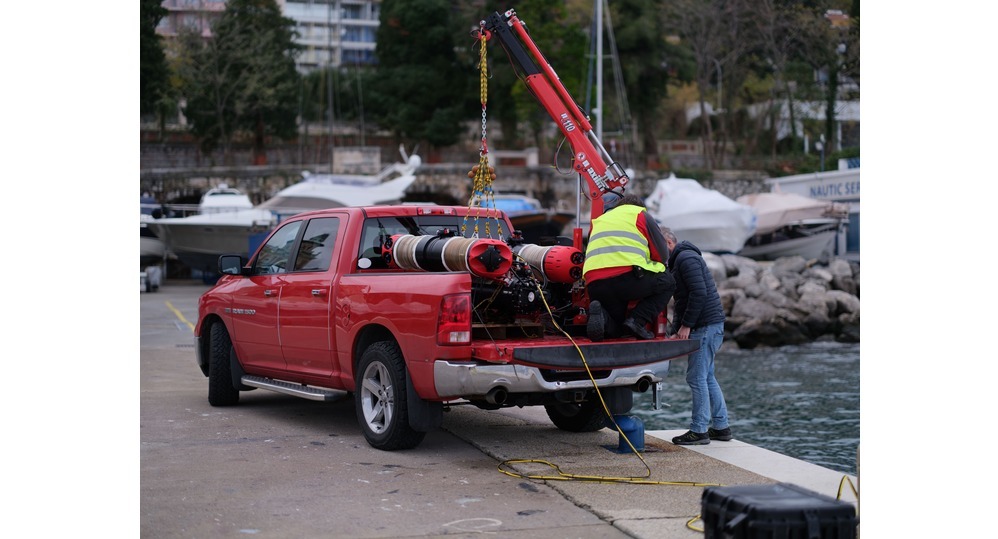Remotely Operated Vehicle for Inspection and Maintenance of Underwater Structures





KEY INFORMATION
TECHNOLOGY OVERVIEW
The current oil and gas market situation and the growing demand for clean energy are driving companies to develop offshore infrastructures for oil and gas extraction and wind farms. Maintenance of underwater structures must be carried out by Remotely Operated Vehicles (ROVs), which can operate 24 hours a day, 7 days a week. However, the daily costs of such operations are high, and companies are looking for innovative solutions to reduce operation time and save costs.
Currently, there are two types of ROVs in use: work-class and inspection ROVs. Work-class ROVs are large and heavy, weighing up to 8 tons, and are capable of performing a variety of tasks. They require vessels and cranes for transportation and deployment and can operate at depths of up to 8000m. They are equipped with specialized tools such as dredgers, robotic arms, LIDARs, and other vision-enhancing electronics. On the other hand, inspection ROVs are small and light, weighing up to 100kg, but have limited capabilities. They can only stream video and perform basic inspections, typically carrying only a camera and sonar. They are usually used at depths of up to 300m.
A startup based in Poland has introduced a new class of ROV that combines the lightness of inspection ROVs with the capabilities of work-class ROVs. The ROV’s patented variable buoyancy hull technology gives it capabilities similar to those of a work-class ROV but with a smaller footprint. It can submerge without using vertical thrusters, making it very energy-efficient and reducing its carbon footprint. The unique variable buoyancy hull approach allows for precise control and intuitive operation, even in the presence of external factors such as sea currents. This technology is particularly useful for subsea missions close to the seabed, as the variable geometry hulls do not disturb sand and dust particles, allowing for better situational awareness for the operator.
This innovative ROV can change their buoyancy to lift more (up to 1:1 payload-to-weight ratio), enabling it to carry various tools and equipment. The ML/AI-based control system automatically changes the buoyancy of the individual hulls, making it intuitive and easy for pilots to control and flattening the learning curve. The technology owner is seeking partnerships with the maritime, defense and other industries in the Southeast Asia region to testbed and tailor the ROV to meet specific application requirements.
TECHNOLOGY FEATURES & SPECIFICATIONS
- Physical
- Depth Rating [msw, meter sea water]: 300
- Dimensions (LxWxH) [mm]: 1600x990x630
- Weight in air [kg]: 200 including battery pack
- Dynamic payload [kg]: 100
- Total payload [kg]: 200
- Maneuverability and propulsion
- 4 horizontal brushless DC thrusters (different options available)
- 2 variable-buoyancy hulls
- No vertical thrusters
- Forward thrust [kgf]: 28
- Lateral thrust [kgf]: 28
- Maximum lift [kgf]: 100
- Speed [kts]: >4
- Video and lighting
- 6 independent cameras
- Video resolution: 4k on each camera
- Video transmission: h.265
- 12 LED Lights (2 per camera)
- Quick & easy camera mounting
- Included 3rd person POV camera arm for intuitive operation
- Pan and tilt platform (optional)
- ROV power
- Battery pack capacity [kWh]: 5.55
- Operating time on one charge (typical inspection work) [hours]: 6
- Time to swap battery pack [minutes]: 5
- Battery pack charging time 0-100% [hours]: 3
POTENTIAL APPLICATIONS
- Disposal of UXO (unexploded ordnance), both for defense and civilian industry, especially at offshore windfarm build sites.
- Inspection of subsea wind farms.
- Cost-effective and eco-friendly solution for tasks such as seabed mapping, undersea structure inspection, and ocean health monitoring.
- Cleaning and maintaining ships without dry dock, which leads to millions of dollars in savings.
- Advanced capabilities in inspection and infrastructure monitoring, particularly in coastal zones, harbors, and seaports.
- Inspection and maintenance of oil and gas infrastructure at depths of up to 300m.
- Inspection of ports and dams.
- Support operation in low-depth underwater mining.
- Inspection of wrecks.
Market Trends & Opportunities
In 2020, worldwide ROV and AUV market was valued at about 2.9 billion dollars, and in 2021, it was over 3.6 billion dollars and rising. The war in Ukraine and the unstable situation with Russia’s oil and gas markets forced other countries to speed up offshore investments in green energy and oil and gas. The ROV’s usability is divided into inspection drones about 54%, work class about 34%, and the rest is for Autonomous Underwater Vehicles. This numbers shows that the drones can address more than 80% of the market and is a game-changing technology.
Unique Value Proposition
- Enhanced inspection class: Utilisation of sensors and tools previously available only to the bigger ROVs.
- Replacing divers: No human life at risk. Unlimited working hours.
- Rapid deployment: Ready to operate in 5 minutes 24/7 uninterrupted operations.
- Exceptional payload capabilities in compact form
- Variable buoyancy technology for precise control
- Modular design for easy integration of various sensing technologies
- Capable of anchoring on the sea-bottom for long-term monitoring
- Electric powered with a low carbon footprint.
